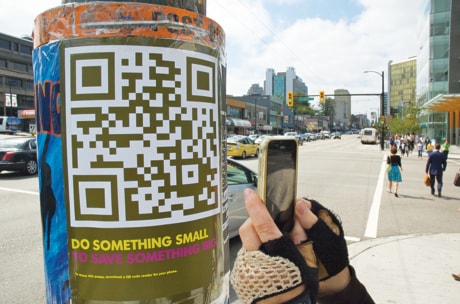VANCOUVER — Mysterious posters are popping up in cities across the country displaying a large black-and-white pattern that looks a little like a maze from a children’s activity book.
Below is a message inviting passersby to scan the pattern using special software on their smartphones, and if they do, they’re brought to a web page featuring a petition to protect the Flathead River Valley in British Columbia and the Restigouche Watershed in Quebec and New Brunswick.
The campaign from the conservation group The Big Wild uses what are called QR codes, which attempt to marry the latest technology with something that sounds like it’s out of last century: bar codes.
“The QR code is one of the new ways to really connect the offline world and the online world,” says Darren Barefoot of The Big Wild, a group founded by Mountain Equipment Co-Op and the Canadian Parks and Wilderness Society.
“These QR codes are essentially ‘more information’ buttons you can click in the real world, you click them by scanning them with an app on your phone and they can pop up text information.”
A QR code is a complex bar code that can hold far more information than the rows of horizontal lines you might be used to seeing on your groceries.
Users who install special software onto their smartphones and aim their cameras at a QR code will either be taken to a website, see a message displayed on their screen, be given a phone number they can call or a number they can send a text message to.
Barefoot notes QR codes have yet to see widespread use in Canada, unlike countries such as Japan where the patterns are used to connect customers to additional information about the products or food they buy or even make purchases.
In this country, some newspapers are using the codes to link printed stories to online content, and a few ad campaigns have tried incorporating them for the same purpose.
But Barefoot says The Big Wild is the first environmental group in Canada to try out the codes, which he hopes will pique interest by using an emerging technology.
“It’s intentionally mysterious, and the hope is that people will sign the petition but they also might think it’s cool and tweet about it and blog about it and post photos of it to Facebook and that kind of thing,” he says.
“I would see this as like a first date with people who sign the petition, because they can opt into our newsletter list, where we can e-mail them more information. This is like a little teaser, a way to get them in the door.”
Posters in Vancouver, Edmonton and Calgary will take users to a web page focused on the Flathead River Valley, a large swath of wilderness in southeastern B.C. Conservation groups such as The Big Wild are urging Ottawa to place stronger, permanent protections on the area.
In Toronto, Ottawa, Montreal and Quebec City, the codes will bring people to a page dedicated to the Restigouche Watershed, which straddles the Quebec and New Brunswick border. The group wants the governments of those two provinces to protect the region from logging and mining.
Technology analyst Carmi Levy says QR codes have yet to catch on in North America, either among consumers or marketers and retailers.
Levy says he hopes that changes, because they offer a quick, easy way to match users with web content related to what they’re seeing in front of them, whether it’s a poster for an environmental campaign, a magazine article or the specs for a big screen TV at the mall.
“That opens up a number of opportunities in the age of the mobile web, simply because you now have a fairly straightforward way of getting information from the real world translated directly into your smartphone,” he says.
“It’s a technology that’s waiting for the world to discover it. Despite the promise that it holds, most of us simply aren’t aware of what it is.”
Levy says the QR code technology is especially useful because it gives users a quick and easy way to get information into their phones, which can be cumbersome despite keyboards and instant access to the web.
“It does illustrate one of the limitations of smartphones in that they don’t do a good job of making it easy to get information from the real world into them. They’re great consumption devices, but they’re not great data entry devices,” he says.
“Anything that makes a smartphone easier to use should be a slam dunk. Wireless carriers, retailers, anyone involved in marketing to consumers should be looking at this as a golden opportunity to connect with consumers in new and interesting ways.”
